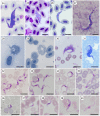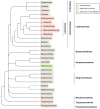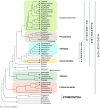Euglenozoa: taxonomy, diversity and ecology, symbioses and viruses
- PMID: 33715388
- PMCID: PMC8061765
- DOI: 10.1098/rsob.200407
Euglenozoa: taxonomy, diversity and ecology, symbioses and viruses
Abstract
Euglenozoa is a species-rich group of protists, which have extremely diverse lifestyles and a range of features that distinguish them from other eukaryotes. They are composed of free-living and parasitic kinetoplastids, mostly free-living diplonemids, heterotrophic and photosynthetic euglenids, as well as deep-sea symbiontids. Although they form a well-supported monophyletic group, these morphologically rather distinct groups are almost never treated together in a comparative manner, as attempted here. We present an updated taxonomy, complemented by photos of representative species, with notes on diversity, distribution and biology of euglenozoans. For kinetoplastids, we propose a significantly modified taxonomy that reflects the latest findings. Finally, we summarize what is known about viruses infecting euglenozoans, as well as their relationships with ecto- and endosymbiotic bacteria.
Keywords: Diplonemida; Euglenida; Kinetoplastida; microbial eukaryotes; phylogeny; systematics.
Figures












References
-
- Leander BS, Lax G, Karnkowska A, Simpson AGB. 2017. Euglenida. In Handbook of the protists (ed. Archibald JM), pp. 1-42. Cham, Switzerland: Springer International Publishing.
Publication types
MeSH terms
LinkOut - more resources
Full Text Sources
Other Literature Sources

